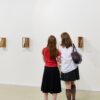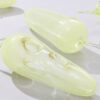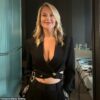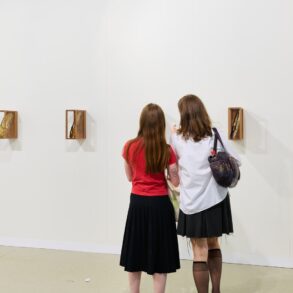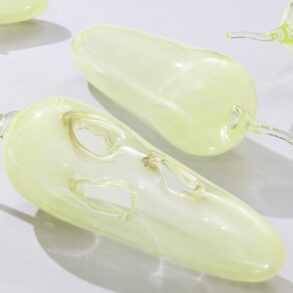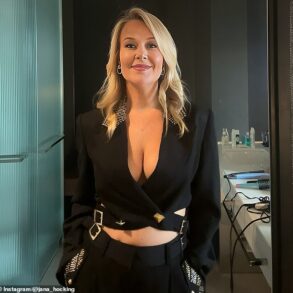There’s a painting from 1857 called Nameless and Friendless. It’s by Emily Mary Osborn and depicts people in an art dealer’s shop like a theatrical scene. Rain pours outside and men are up on ladders, writing down records, or wearing top hats with their faces lit up as they peer over newspapers, all directing our gaze to the main event.
Standing in the middle is a woman in a Victorian dress. She looks forlorn, worn-down, helpless, exhausted. A small boy stands by her side, far more upright, with rosy cheeks in drastic contrast to hers, which are ghostly pale. She’s waiting nervously for a response from an older man, who stands behind a bureau, inspecting a small canvas. Could this belong to her, or could this be by her? Judging by his curious look, he isn’t impressed.
This painting – featured in Now You See Us, Women Artists in Britain: 1520-1920, a show just opened at Tate Britain in London – sums up what life must have been like for Victorian women in the 1850s. In this male-dominated society, women were practically invisible, except in the home, and not taken seriously as professionals. They belonged to men: legally, they were the property of their husband or father, and had no vote. If a woman wanted to become an artist, she was banned from studying the nude. After 20 years of campaigning, the Royal Academy permitted women from 1893. And there was no state-funded education (the Slade school of fine art opened in 1871).
There was little chance of selling her art, too. It was common for art dealers to scratch out a woman’s name and replace it with a more commercial male’s, which is why so many artworks are now coming to light.
It would take eight decades from the time of Osborn’s painting for a woman to be elected as a Royal Academician (Laura Knight in 1936) and 166 years until one would get a major solo exhibition in all of the museum’s main galleries (2023, Marina Abramović). It was also when leading Victorian art critic John Ruskin wrote: “The man’s power is active, progressive, defensive. He is eminently the doer, the creator, the discoverer, the defender […] But the woman’s power is for rule, not for battle – and her intellect is not for invention or creation.”
Despite this, women created, invented, did, discovered and – as this groundbreaking, historic exhibition shows – broke out of the confines of their gender, found canny ways to get around their restrictions and conquered every genre, size, scale and form. From collage to painting, sculpture to photography, they painted charging horses, flowers in needlepainting and immortalised themselves not only as artists at the easel but, in the case of Louise Jopling, pregnant artists – in a painting Tate has now acquired. Jopling went on to found an art school for women in the 1880s.
These women showed us what it feels like to be locked out – but they had a laugh, too. Florence Claxton’s Woman’s Work presents an outdoor scene centred on a man with a golden calf on a plinth behind him (a reference to the worshipping of false gods). He is surrounded by women either pointing towards the horizon for opportunities (because there were none), or gazing in the mirror (because who needs an education when you have your appearance?). But like all dark comedies, it makes light of the grim realities for women.

What struck me while walking around Now You See Us was how little I knew. How did history get away with depriving us of these artists? It’s not like they weren’t recorded. Mary Beale’s husband wrote down every sale, patron and collection she made it into. Was it a conscious decision to leave women out, or was it that they just didn’t look?
What I love about this show is it’s an exhibition through time: from the 1500s to 1900s. As you walk from room to room, you see women inching closer to liberation, with each generation strengthening the following one. By the time I reached the last room, it felt as if all these artists were standing on the shoulders of those who came before. They could now vote, travel, earn money and express themselves as never before. And it’s thanks to them we have our freedoms today.
after newsletter promotion
I’ve been in Australia witnessing the after-effects of Know My Name, a 2019 exhibition organised by the National Gallery of Australia that brought together more than 150 female Australian artists. As a result, in 2022, 55% of the total artworks acquired by the NGA were by women, as were 64% of the works in special exhibitions. Not only have there been countless offshoot exhibitions around the country, the museum also vowed to reinforce its commitment to gender equality with internationally touring exhibitions by women. This includes Emily Kame Kngwarreye, whose work comes to London’s Tate Modern in 2025.
This is a global moment – one that proves women have always been creative, they just weren’t seen. Now they are, they are no longer nameless and friendless. Yes, we finally see them, on a national stage, and future generations can grow up knowing the truth.
-
Now You See Us is at Tate Britain, London, until 13 October
This post was originally published on this site be sure to check out more of their content

